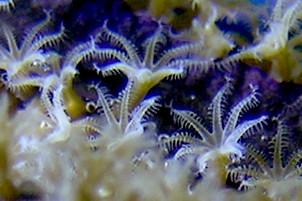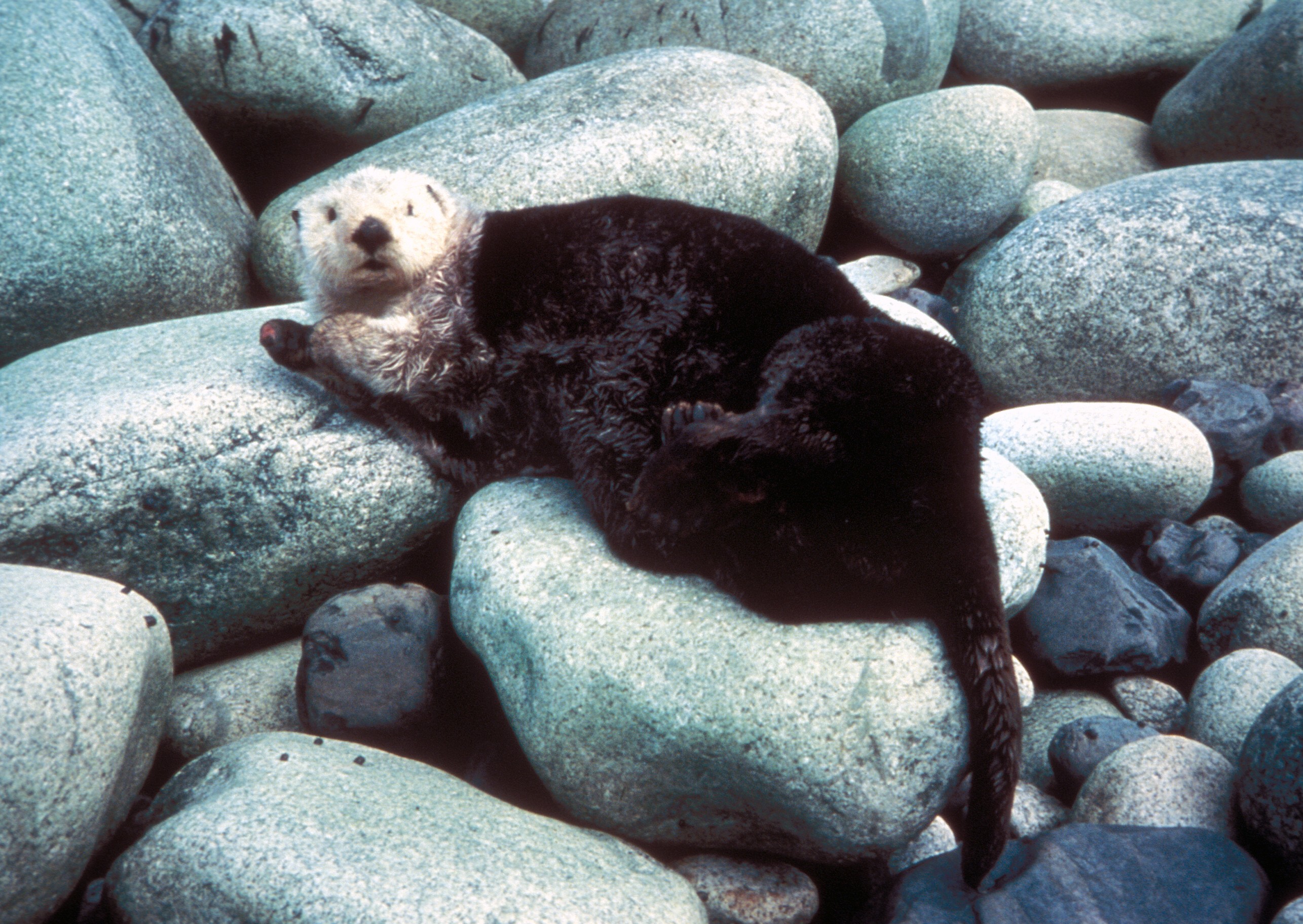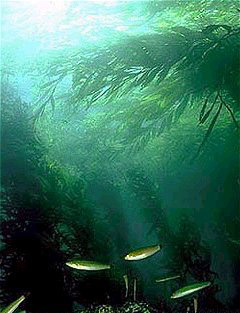|
Coastal Ecology
A marine coastal ecosystem is a marine ecosystem which occurs where the land meets the ocean. Worldwide there is about of coastline. Coastal habitats extend to the margins of the continental shelves, occupying about 7 percent of the ocean surface area. Marine coastal ecosystems include many very different types of marine habitats, each with their own characteristics and species composition. They are characterized by high levels of biodiversity and productivity. For example, estuaries are areas where freshwater rivers meet the saltwater of the ocean, creating an environment that is home to a wide variety of species, including fish, shellfish, and birds. Salt marshes are coastal wetlands which thrive on low-energy shorelines in temperate and high-latitude areas, populated with salt-tolerant plants such as cordgrass and marsh elder that provide important nursery areas for many species of fish and shellfish. Mangrove forests survive in the intertidal zones of tropical or subtropi ... [...More Info...] [...Related Items...] OR: [Wikipedia] [Google] [Baidu] |
Muriwai Beach Gannet Colony
Muriwai, also called Muriwai Beach, is a coastal community on the west coast of the Auckland Region in the North Island of New Zealand. The black-sand surf beach and surrounding area is a popular recreational area for Aucklanders. The Muriwai Regional Park includes a nesting site for a large colony of Australasian gannet, gannets. The New Zealand Ministry for Culture and Heritage gives a translation of "water's end" for ''Muriwai''. Geology The Muriwai area was uplifted from the sea floor between 3 and 5 million years ago. Much of the landscape is formed by remnants of the eastern side of the Waitākere Volcano, notably the pillow lava formations seen along the cliffs south of Muriwai beach. The area is primarily formed by sand, sedimentary rock and piha conglomerate. Cliff walls dominate much of southern Muriwai. Muriwai Beach has black sand, caused by the iron content derived from the ancient volcanoes in the area, including the large Kaipara Volcano which was situated o ... [...More Info...] [...Related Items...] OR: [Wikipedia] [Google] [Baidu] |
Coral Polyp
A polyp in zoology is one of two forms found in the phylum Cnidaria, the other being the medusa. Polyps are roughly cylindrical in shape and elongated at the axis of the vase-shaped body. In solitary polyps, the aboral (opposite to oral) end is attached to the substrate by means of a disc-like holdfast called a pedal disc, while in colonies of polyps it is connected to other polyps, either directly or indirectly. The oral end contains the mouth, and is surrounded by a circlet of tentacles. Classes In the class Anthozoa, comprising the sea anemones and corals, the individual is always a polyp; in the class Hydrozoa, however, the individual may be either a polyp or a medusa, with most species undergoing a life cycle with both a polyp stage and a medusa stage. In the class Scyphozoa, the medusa stage is dominant, and the polyp stage may or may not be present, depending on the family. In those scyphozoans that have the larval planula metamorphose into a polyp, the polyp, also ... [...More Info...] [...Related Items...] OR: [Wikipedia] [Google] [Baidu] |
Sequester Carbon
Carbon sequestration is the process of storing carbon in a carbon pool. It plays a crucial role in limiting climate change by reducing the amount of carbon dioxide in the atmosphere. There are two main types of carbon sequestration: biologic (also called ''biosequestration'') and geologic. Biologic carbon sequestration is a naturally occurring process as part of the carbon cycle. Humans can enhance it through deliberate actions and use of technology. Carbon dioxide () is naturally captured from the atmosphere through biological, chemical, and physical processes. These processes can be accelerated for example through changes in land use and agricultural practices, called carbon farming. Artificial processes have also been devised to produce similar effects. This approach is called carbon capture and storage. It involves using technology to capture and sequester (store) that is produced from human activities underground or under the sea bed. Plants, such as forests and kelp ... [...More Info...] [...Related Items...] OR: [Wikipedia] [Google] [Baidu] |
Marine Biogeochemical Cycle
Marine biogeochemical cycles are biogeochemical cycles that occur within Marine habitat, marine environments, that is, in the saline water, saltwater of seas or oceans or the brackish water of coastal Estuary, estuaries. These biogeochemical cycles are the pathways chemical substances and chemical element, elements move through within the marine environment. In addition, substances and elements can be imported into or exported from the marine environment. These imports and exports can occur as exchanges with the atmosphere above, the ocean floor below, or as runoff from the land. There are biogeochemistry, biogeochemical cycles for the elements calcium cycle, calcium, carbon cycle, carbon, hydrogen cycle, hydrogen, mercury cycle, mercury, nitrogen cycle, nitrogen, oxygen cycle, oxygen, phosphorus cycle, phosphorus, selenium cycle, selenium, and sulfur cycle, sulfur; molecular cycles for water cycle, water and silica cycle, silica; macroscopic cycles such as the rock cycle; as we ... [...More Info...] [...Related Items...] OR: [Wikipedia] [Google] [Baidu] |
Nutrient Cycle
A nutrient cycle (or ecological recycling) is the movement and exchange of inorganic and organic matter back into the production of matter. Energy flow is a unidirectional and noncyclic pathway, whereas the movement of mineral nutrients is cyclic. Mineral cycles include the carbon cycle, sulfur cycle, nitrogen cycle, water cycle, phosphorus cycle, oxygen cycle, among others that continually recycle along with other mineral nutrients into productive ecological nutrition. Overview The nutrient cycle is nature's recycling system. All forms of recycling have feedback loops that use energy in the process of putting material resources back into use. Recycling in ecology is regulated to a large extent during the process of decomposition. Ecosystems employ biodiversity in the food webs that recycle natural materials, such as mineral nutrients, which includes water. Recycling in natural systems is one of the many ecosystem services that sustain and contribute to the well-being ... [...More Info...] [...Related Items...] OR: [Wikipedia] [Google] [Baidu] |
Ecosystem Service
Ecosystem services are the various benefits that humans derive from ecosystems. The interconnected living and non-living components of the natural environment offer benefits such as pollination of crops, clean air and water, decomposition of wastes, and flood control. Ecosystem services are grouped into four broad categories of services. There are ''provisioning services'', such as the production of food and water; ''regulating services'', such as the control of climate and disease; ''supporting services'', such as nutrient cycles and oxygen production; and ''cultural services'', such as recreation, tourism, and spiritual gratification. Evaluations of ecosystem services may include assigning an economic value to them. For example, estuarine and coastal ecosystems are marine ecosystems that perform the four categories of ecosystem services in several ways. Firstly, their provisioning services include marine resources and genetic resources. Secondly, their supporting services inc ... [...More Info...] [...Related Items...] OR: [Wikipedia] [Google] [Baidu] |
Sea Urchin
Sea urchins or urchins () are echinoderms in the class (biology), class Echinoidea. About 950 species live on the seabed, inhabiting all oceans and depth zones from the intertidal zone to deep seas of . They typically have a globular body covered by a spine (zoology), spiny protective test (biology), tests (hard shells), typically from across. Sea urchins move slowly, crawling with their tube feet, and sometimes pushing themselves with their spines. They feed primarily on algae but also eat slow-moving or sessility (motility), sessile animals such as crinoids and sponges. Their predators include sharks, sea otters, starfish, wolf eels, and triggerfish. Like all echinoderms, adult sea urchins have pentagonal symmetry with their Echinoderm#Larval development, pluteus larvae featuring Bilateral symmetry, bilateral (mirror) symmetry; The latter indicates that they belong to the Bilateria, along with chordates, arthropods, annelids and molluscs. Sea urchins are found in every ocea ... [...More Info...] [...Related Items...] OR: [Wikipedia] [Google] [Baidu] |
Sea Otter
The sea otter (''Enhydra lutris'') is a marine mammal native to the coasts of the northern and eastern Pacific Ocean, North Pacific Ocean. Adult sea otters typically weigh between , making them the heaviest members of the Mustelidae, weasel family, but among the smallest marine mammals. Unlike most marine mammals, the sea otter's primary form of insulation is an exceptionally thick coat of fur, the densest in the animal kingdom. Although it can walk on land, the sea otter is capable of living exclusively in the ocean. The sea otter inhabits nearshore environments, where it dives to the sea floor to Foraging, forage. It preys mostly on marine Invertebrate, invertebrates such as sea urchins, various mollusks and crustaceans, and some species of fish. Its foraging and eating habits are noteworthy in several respects. Its Tool use by sea otters, use of rocks to dislodge prey and to open shells makes it one of the few mammal species to use tools. In most of ... [...More Info...] [...Related Items...] OR: [Wikipedia] [Google] [Baidu] |
Kelp
Kelps are large brown algae or seaweeds that make up the order (biology), order Laminariales. There are about 30 different genus, genera. Despite its appearance and use of photosynthesis in chloroplasts, kelp is technically not a plant but a stramenopile (a group containing many protists). Kelp grow from stalks close together in kelp forest, very dense areas like forests under shallow temperate and Arctic oceans. They were previously thought to have appeared in the Miocene, 5 to 23 million years ago based on fossils from California. New fossils of kelp holdfasts from early Oligocene rocks in Washington State show that kelps were present in the northeastern Pacific Ocean by at least 32 million years ago. The organisms require nutrient-rich water with temperatures between . They are known for their high growth rate—the genera ''Macrocystis'' and ''Nereocystis'' can grow as fast as half a metre a day (that is, about 20 inches a day), ultimately reaching .Thomas, D. 2002. ''Seaweed ... [...More Info...] [...Related Items...] OR: [Wikipedia] [Google] [Baidu] |
Brown Algae
Brown algae (: alga) are a large group of multicellular algae comprising the class (biology), class Phaeophyceae. They include many seaweeds located in colder waters of the Northern Hemisphere. Brown algae are the major seaweeds of the temperate and polar regions. Many brown algae, such as members of the order Fucales, commonly grow along rocky seashores. Most brown algae live in marine environments, where they play an important role both as food and as a potential habitat. For instance, ''Macrocystis'', a kelp of the order Laminariales, may reach in length and forms prominent underwater kelp forests that contain a high level of biodiversity. Another example is ''Sargassum'', which creates unique floating mats of seaweed in the tropical waters of the Sargasso Sea that serve as the habitats for many species. Some members of the class, such as kelps, are used by humans as food. Between 1,500 and 2,000 species of brown algae are known worldwide. Some species, such as ''Ascophyllum ... [...More Info...] [...Related Items...] OR: [Wikipedia] [Google] [Baidu] |
Kelp Forest
Kelp forests are underwater areas with a high density of kelp, which covers a large part of the world's coastlines. Smaller areas of anchored kelp are called kelp beds. They are recognized as one of the most productive and dynamic ecosystems on Earth. Although algal kelp forest combined with coral reefs only cover 0.1% of Earth's total surface, they account for 0.9% of global Primary production, primary productivity. Kelp forests occur worldwide throughout temperate and polar region, polar coastal oceans. In 2007, kelp forests were also discovered in tropical waters near Ecuador. Physically formed by brown macroalgae, kelp forests provide a unique habitat for marine organisms and are a source for understanding many ecological processes. Over the last century, they have been the focus of extensive research, particularly in Trophic dynamics, trophic ecology, and continue to provoke important ideas that are relevant beyond this unique ecosystem. For example, kelp forests can infl ... [...More Info...] [...Related Items...] OR: [Wikipedia] [Google] [Baidu] |
Dugong
The dugong (; ''Dugong dugon'') is a marine mammal. It is one of four living species of the order Sirenia, which also includes three species of manatees. It is the only living representative of the once-diverse family Dugongidae; its closest modern relative, Steller's sea cow (''Hydrodamalis gigas''), was hunted to extinction in the 18th century. The dugong is the only sirenian in its range, which spans the waters of some 40 countries and territories throughout the Indo-West Pacific. The dugong is largely dependent on seagrass communities for subsistence and is thus restricted to the coastal habitats that support seagrass meadows, with the largest dugong concentrations typically occurring in wide, shallow, protected areas such as bays, mangrove channels, the waters of large inshore islands, and inter-reefal waters. The northern waters of Australia between Shark Bay and Moreton Bay are believed to be the dugong's contemporary stronghold. Like all modern sirenians, the d ... [...More Info...] [...Related Items...] OR: [Wikipedia] [Google] [Baidu] |










